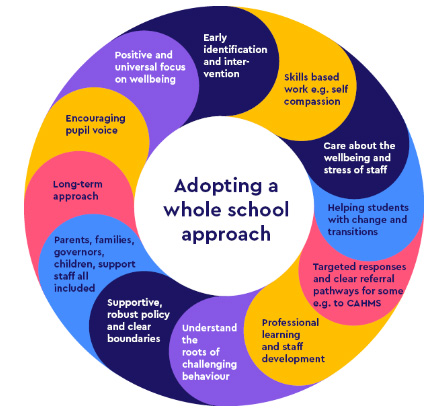Whole School Approach

‘In a whole school approach, wellbeing and mental health are everyone's business,’ with genuine engagement across the entire community: staff, pupils, governors, parents and external services. The approach involves multiple components including early identification and intervention; staff wellbeing and development; and skills-based work for pupils, but above all it adopts a positive and universal focus on wellbeing.
Why have a whole school approach?
- Improved pupil wellbeing
- Improved staff wellbeing and retention
- Improved academic learning
- Strong link to improving school’s overall effectiveness
- Development of social and emotional skills
- Prevention of MH problems
- Improved school behaviour - reduction in fights, bullying, exclusions and absence
Gloucestershire resource: Nurturing Schools and Colleges
GHLL worked with partners to produce the Nurturing Schools and Colleges: Whole School Approaches to Supporting Mental Health and Emotional Wellbeing resource.
A whole-school approach is the best way to bring about changes to policy and practice to ensure everyone is fully on board, from governors to classroom assistants. The research tells us that a whole school commitment and ethos, rather than piecemeal approaches, are key to making a difference. This resource seeks to bring together the wealth of available materials, information and research regarding whole-school approaches to supporting wellbeing, so that senior leaders and practitioners working with young people can see a comprehensive overview of what they can do at whole school level to foster relationships, support children and young people’s emotional wellbeing and mental health, and also where support can be sought if needed.
The whole-school approach seeks to support good emotional and mental well-being by promoting a positive cultural environment in schools, where children and young people form positive relationships with staff and other learners, and relationships are strengthened:
• between teaching staff
• with the school senior leadership team and wider school staff
• with parents and carers
• with other professionals working with the school
• with the wider community that surrounds the school.
It is about embedding good well-being through teaching as well as all the other aspects of school life.
It is an ethos that:
• values inclusion, where everybody works together, contributing their individual skills and resources to the collective good
• creates a supportive environment where young people are encouraged to fulfil their personal and academic potential, where they thrive, learn and emotionally develop, supported by teachers who operate in a culture that equally values their own well-being.
Ideally, wellbeing and resilience should be on the School Improvement Plan and leaders, including governors, should be able to talk about how the school vision reflects this. Staff, pupils and parents should be able to talk about wellbeing and resilience and what this means
for them and others in the school. And the overall culture of the school should be fostered to support the most vulnerable children and young people.
A group of schools were asked to imagine what an ideal resilient school would look like. Through the lens of the whole school, these are some of the things they suggested:
Whole school:
- Attainment will improve because children are in the right place to learn
- Flat hierarchy – everyone’s input is equally valued
- Staff and pupil wellbeing is a priority
- Time for supervision/reflection (formal)
- Therapeutic interventions as important as academic (eg sensory play, circuits, yoga)
- Staff all skilled at dealing with wellbeing issues

Key resources
Since 2014, the Partnership for Wellbeing and Mental Health in Schools has produced a number of consultation responses to new and proposed legislation, briefing documents and resources for schools, as well as the Whole School Approach framework which has since been adopted in schools across the country. These resources support practitioners to understand, embed and assess a whole school approach in their schools and colleges:
Self-assessment and improvement tool for school leaders
RHSE Guidance for Schools consultation joint response (2018)
What works? Wellbeing in Schools Guidance (2015)
Whole School Approach supporting resources for school leaders (2016)
Tagged under: whole school approach, framework, resources, mental health, wellbeing
Was the information on this page helpful? 



